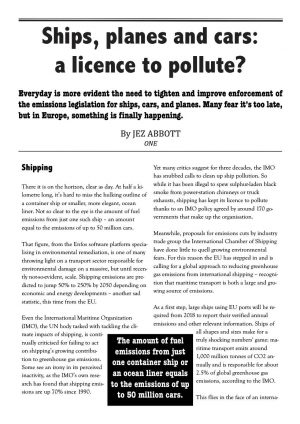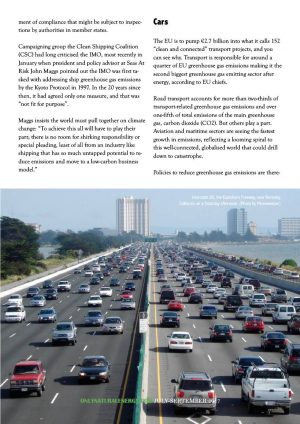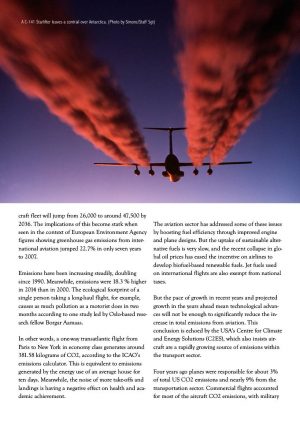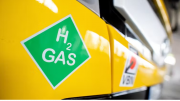Shipping
 There it is on the horizon, clear as day. At half a kilometre long, it’s hard to miss the hulking outline of a container ship or smaller, more elegant, ocean liner. Not so clear to the eye is the amount of fuel emissions from just one such ship – an amount equal to the emissions of up to 50 million cars.
There it is on the horizon, clear as day. At half a kilometre long, it’s hard to miss the hulking outline of a container ship or smaller, more elegant, ocean liner. Not so clear to the eye is the amount of fuel emissions from just one such ship – an amount equal to the emissions of up to 50 million cars.
That figure, from the Enfos software platform specialising in environmental remediation, is one of many throwing light on a transport sector responsible for environmental damage on a massive, but until recently not-so-evident, scale. Shipping emissions are predicted to jump 50% to 250% by 2050 depending on economic and energy developments – another sad statistic, this time from the EU.
Even the International Maritime Organization (IMO), the UN body tasked with tackling the climate impacts of shipping, is continually criticised for failing to act on shipping’s growing contribution to greenhouse gas emissions. Some see an irony in its perceived inactivity, as the IMO’s own research has found that shipping emissions are up 70% since 1990.
Yet many critics suggest for three decades, the IMO has snubbed calls to clean up ship pollution. So while it has been illegal to spew sulphur-laden black smoke from power-station chimneys or truck exhausts, shipping has kept its licence to pollute thanks to an IMO policy agreed by around 170 governments that make up the organisation.
Meanwhile, proposals for emissions cuts by industry trade group the International Chamber of Shipping have done little to quell growing environmental fears. For this reason the EU has stepped in and is calling for a global approach to reducing greenhouse gas emissions from international shipping – recognition that maritime transport is both a large and growing source of emissions.
As a first step, large ships using EU ports will be required from 2018 to report their verified annual emissions and other relevant information. Ships of all shapes and sizes make for a truly shocking numbers’ game: maritime transport emits around 1,000 million tonnes of CO2 annually and is responsible for about 2.5% of global greenhouse gas emissions, according to the IMO.
This flies in the face of an internationally agreed goal of keeping global temperature increase to below 2°C compared to pre-industrial levels, requiring worldwide emissions to be at least halved from 1990 levels by 2050. Yet ships’ energy consumption and CO2 emissions could be cut by up to 75% by operational changes and using existing technologies, according to another IMO report.
Many of these measures are cost-effective and reduce fuel bills. Another study, by National Oceanic and Atmospheric Administration (NOAA), found the particulate matter given off by container ships has contributed to over 60,000 premature deaths per year. The health dangers are highest around busy shipping areas like the Mediterranean, India and East Asia.
And cruise liners fare little better. According to a report in the UK’s Guardian newspaper, the world’s largest cruiser has a “supersized pollution problem”. The Harmony of the Seas set sail from Southampton docks on the south coast of England last May on its first commercial voyage. The 16-storey ship has two engines that together burn about 66,000 US gallons of fuel a day at full power.
According to the report, a resident and member of Southampton Clean Air environmental group, insists fumes from cruise liners and bulk cargo ships are “definitely” contributing to Southampton’s highly polluted air. Colin MacQueen adds: “We can smell, see and taste it”.
“These ships,” he said, “are like blocks of flats. Sometimes there are five or more in the docks at the same time. The wind blows their pollution directly into the city, and as far we can tell, there is no monitoring of their pollution. We are pushing for them to use shore power but they have resisted.”
Royal Caribbean, which owns Harmony of the Seas and made a legal complaint about the article, insists the latest, most efficient pollution control systems are used, and the ship meets all legal requirements. Industry body Cruise Lines International Association (CLIA) meanwhile adds that companies have invested significantly to develop new technologies to help reduce air emissions.
But marine pollution analysts in Germany and Brussels say such large ships will probably burn at least 150 tonnes of fuel a day, and emit more sulphur than several million cars, more NO2 gas than all the traffic passing through a medium-sized town and more particulate emissions than thousands of London buses. Some feel it is too late to act.
Many environmental commentators insisted before the landmark Paris Agreement on climate change of 2015 that without the inclusion of ship greenhouse gas emissions in the agreement and significant additional action to reduce emissions, shipping would swallow a growing proportion of the 2°C carbon budget. Ultimately it would be nearly impossible to meet climate targets.
That has not stopped the European Commission (EC) trying to set the world on a course that avoids dangerous climate change. The Commission is contributing €10 million to a joint EC-IMO four-year energy-efficiency project to try and set up maritime technology cooperation centres in five regions: Africa, Asia, the Caribbean, Latin America and the Pacific.
The centres will work together to build up technical expertise and capacity to promote uptake of low-carbon technologies and operations in less developed countries. They will also support the implementation of internationally agreed energy efficiency rules and standards. The net is further closing on heavily polluting large ships.
From January 2018, ships over 5 000 tonnes docking into EU ports must monitor and report CO2 emissions and other data. Monitoring, reporting and verification (MRV) of information will be strictly regulated. Details will include fuel consumption, distance travelled, time at sea and cargo, to gather annual data into a emissions report submitted to an accredited MRV shipping verifier.
A year later in 2019, MRV companies will annually submit to the commission a satisfactorily verified emissions report for each of ship.
Furthermore, all ships will carry on board a document of compliance that might be subject to inspections by authorities in member states.
Campaigning group the Clean Shipping Coalition (CSC) had long criticised the IMO, most recently in January when president and policy advisor at Seas At Risk John Maggs pointed out the IMO was first tasked with addressing ship greenhouse gas emissions by the Kyoto Protocol in 1997. In the 20 years since then, it had agreed only one measure, and that was “not fit for purpose”.
Maggs insists the world must pull together on climate change: “To achieve this all will have to play their part; there is no room for shirking responsibility or special pleading, least of all from an industry like shipping that has so much untapped potential to reduce emissions and move to a low-carbon business model.”
Cars and trucks
 The EU is to pump €2.7 billion into what it calls 152 “clean and connected” transport projects, and you can see why. Transport is responsible for around a quarter of EU greenhouse gas emissions making it the second biggest greenhouse gas emitting sector after energy, according to EU chiefs.
The EU is to pump €2.7 billion into what it calls 152 “clean and connected” transport projects, and you can see why. Transport is responsible for around a quarter of EU greenhouse gas emissions making it the second biggest greenhouse gas emitting sector after energy, according to EU chiefs.
Road transport accounts for more than two-thirds of transport-related greenhouse gas emissions and over one-fifth of total emissions of the main greenhouse gas, carbon dioxide (CO2). But others play a part. Aviation and maritime sectors are seeing the fastest growth in emissions, reflecting a looming spiral to this well-connected, globalised world that could drill down to catastrophe.
Policies to reduce greenhouse gas emissions are therefore required for several transport modes. While greenhouse gas emissions from other sectors fell 15% between 1990 and 2007, those from transport shot up 36% in the same period, says the EU. This rise is despite improved vehicle efficiency because more people and freight are hitching a ride on trucks, trains, ships and planes.
Hence the timeliness for the €2.7 billion for all those clean and connected transport projects. Some of that money will be used to upgrade rail lines, smooth out traffic ‘bottlenecks’ and improve cross-border connections. In so doing, the EU leaders hope to not only modernise Europe’s transport but spur job creation and stimulate economic activity.
This first tranche of funding, for example, is expected to unlock a further €4.7 billion of other public and private finance. The EC and the European Investment Bank created a Cleaner Transport Facility (CTF) to pump cash into alternative fuels and technology. A super-fast charging network for electric vehicles linking Sweden, Denmark, Germany, France, the UK and Italy is one beneficiary.
And in late June this year EU commissioner for transport Violeta Bulc insisted: “This new wave of investment focuses on clean, innovative and digital projects to modernise Europe’s transport network. We are one step closer to a true transport union, serving the needs of citizens, stimulating the economy and creating jobs.”
A month later, this July, The European Commission told Brussels-based think tank Friends of Europe and a panel on the future of road freight transport it was moving to introduce legislative proposals for the booming truck sector. The panel heard that lorries were often “the forgotten elephant in the room” in terms of fuel consumption and carbon emissions.
“Trucks are the fastest growing sector in terms of oil demand,” said International Energy Agency (IEA) executive director Fatih Birol. “At 17 million barrels per day, it is one-fifth of the global oil demand. But there has been little public attention and not enough policy measures, partly because there are one billion cars in the world and only 60 million trucks.”
However, truck transport nevertheless accounted for 35% of transport-related CO2 emissions and cars only slightly more, at 40%. Birol said the USA, Canada, Japan and China already had fuel efficiency standards for trucks in place and Europe was lagging behind. More focus was needed on fuel efficiency, road freight traffic logistics and use of alternative fuels.
Commission vice-president for energy Maroš Šefčovič, said: “Freight transport is not overlooked but there is a sense of urgency to act. Our estimate suggests freight transport in Europe will grow significantly, by 60% between 2010 to 2050. So we are already in that growth curve and the figures make it obvious that we must take action”.
Europe is not alone in feeling mounting alarm at the high environmental cost of transport. According to the US government’s Environmental Protection Agency, transportation accounted for 27% of all greenhouse gas emissions in 2015 – nearly a third. Over 90% of fuel used for transport is petroleum based, with gasoline and diesel exacting a heavy, but relatively low-key toll.
Industry, on the other hand, often seen as public-enemy number one for the environment, recorded 21% of 2015 greenhouse gas emissions. So all that fossil-fuel-burning energy and production of raw materials belches out 6% fewer emissions than transport. Conventional wisdom suggests decarbonisation must await innovations in car batteries, hydrogen storage and biofuels.
But a recent report from Simon Fraser University sought to change this accepted narrative. Driving Decarbonization: Pathways and Policies for Canadian Transport looked at how lifestyle changes such as energy efficiency, fuel switching, and urban redesign could cut transport emissions against a backdrop of policy change to encourage people, institutions and corporations to mend their ways.
Examples, where the use of gasoline and diesel have fallen rapidly in recent years, include Brazil during the 1980s and, more recently, Sweden, which is reducing gasoline and diesel use in buses and trucks. During the first half of 2016, biodiesel accounted for almost a quarter of all diesel fuel delivered to the Swedish transport fuel market.
This is according to an analysis made by environmental group Svebio and the Swedish Bioenergy Association and based on data from Statistics Sweden. Biodiesel includes hydrogenated vegetable oils (HVO) and fatty acid methyl esters (FAME). HVO is based on feedstock like tall oil from pulp industries, recycled vegetable oils, and fats. FAME is mainly rapeseed-based diesel.
Canada can follow suit by introducing ethanol in vehicles and 100% biodiesel in modified trucks, reckons Mark Jaccard, who co-authored Driving Decarbonization: Pathways and Policies for Canadian Transport. Vehicles using electricity and maybe hydrogen will ultimately play a fundamental role with a little nudge from the political classes, he believes, with “just a bit of political leadership.”
That political leadership looks something like this: in July, nearly €4 million in European funds was awarded to low-carbon travel projects in Scotland, the UK. Five organisations such as municipal authorities will receive European Regional Development Fund (ERDF) cash to develop low-carbon transport hubs. One will have a solar canopy and electric vehicle charging stations.
Perth and Kinross Council will use its cash to introduce a hydrogen refuelling station and more electric vehicle charging points. It will also pay for the upgrading of an electricity sub-station to provide ultra-rapid charging. The solar PV canopy with battery storage system will support the charging stations. Similar hubs are to be built in Aberdeen, North Ayrshire, Dundee and Falkirk.
Announcing the funding awards on ERDF minister for transport Humza Yousaf said: “ERDF Low Carbon Travel and Transport Challenge Fund provides a fantastic opportunity to help individuals, communities and our population benefit from sustainable and greener travel options.”
Aviation
 Hopping on a plane and jetting off for a weekend break has never had such dire consequences. All those air-miles may save you money and contribute to economic growth. But elsewhere the costs are stacking up alarmingly, such as on human health, climate, and the environment.
Hopping on a plane and jetting off for a weekend break has never had such dire consequences. All those air-miles may save you money and contribute to economic growth. But elsewhere the costs are stacking up alarmingly, such as on human health, climate, and the environment.
The number of flights in Europe in 2014 was about 80% higher than in 1990, according to figures from the European Environment Agency. And after a drop caused by the global economic recession from 2008 onwards, the numbers are picking up again, fuelled by low-cost flights and new routes that offer travellers evermore choice and destinations.
UN regulator the International Civil Aviation Organisation (ICAO) projects the world’s commercial aircraft fleet will jump from 26,000 to around 47,500 by 2036. The implications of this become stark when seen in the context of European Environment Agency figures showing greenhouse gas emissions from international aviation jumped 22.7% in only seven years to 2007.
Emissions have been increasing steadily, doubling since 1990. Meanwhile, emissions were 18.3 % higher in 2014 than in 2000. The ecological footprint of a single person taking a long-haul flight, for example, causes as much pollution as a motorist does in two months according to one study led by Oslo-based research fellow Borgar Aamaas.
In other words, a one-way transatlantic flight from Paris to New York in economy class generates around 381.58 kilograms of CO2, according to the ICAO’s emissions calculator. This is equivalent to emissions generated by the energy use of an average house for ten days. Meanwhile, the noise of more take-offs and landings is having a negative effect on health and academic achievement.
The aviation sector has addressed some of these issues by boosting fuel efficiency through improved engine and plane designs. But the uptake of sustainable alternative fuels is very slow, and the recent collapse in global oil prices has eased the incentive on airlines to develop biofuel-based renewable fuels. Jet fuels used on international flights are also exempt from national taxes.
But the pace of growth in recent years and projected growth in the years ahead mean technological advances will not be enough to significantly reduce the increase in total emissions from aviation. This conclusion is echoed by the USA’s Centre for Climate and Energy Solutions (C2ES), which also insists aircraft are a rapidly growing source of emissions within the transport sector.
Four years ago planes were responsible for about 3% of total US CO2 emissions and nearly 9% from the transportation sector. Commercial flights accounted for most of the aircraft CO2 emissions, with military and general aviation making up the rest. And recent studies estimate US aircraft emissions will increase substantially in the next 20 years. This increasingly interconnected global aviation sector makes up about 2% of global CO2 emissions but is one of the fastest growing sources, according to C2ES. From 1990 to 2010 global aircraft CO2 emissions grew about 40%. If global aviation were a country, it would rank as the seventh largest CO2 emitter, and US aircraft emissions are 29% of all global aircraft emissions.
Without new policies, global aircraft emissions are projected to triple by 2050. For this reason, last October the International Civil Aviation Organization (ICAO) created a global offsetting scheme called the Carbon Offsetting and Reduction Scheme for International Aviation (CORSIA) to address those rapidly growing emissions from aviation.
And in February this year, the European Commission responded to ICAO’s scheme by publishing a proposal on how to treat aviation emissions under an EU Emissions Trading System (EU ETS). The agreement reached by the ICAO foresaw the establishment of system that will oblige airlines to offset the growth of their CO2 emissions after 2020 by buying ’emission units’.
In other words airlines will spend money on projects reducing CO2 emissions in other sectors of the economy such as renewable energies to notch up their units. In its first phase, from 2021 to 2026, 65 countries will participate on a voluntary basis and thereafter it will become mandatory. The goal is to offset 80% of the emissions by the scheme between 2021 and 2035.
Not good enough according to some commentators, who argue Europe is calling for a considerably less ambitious carbon emissions standard for air planes than the US. A former flight test engineer and senior aerospace lecturer at Delft University in the Netherlands, Joris Melkert, told the UK’s Guardian newspaper, the Europe’s proposals were less ambitious by a long way than the USA’s.
Under the proposals, a co-called stringency option of ‘9’ suggested by the US would reduce overall aircraft emissions by 37.5%. A ‘7’ setting favoured by the EU would imply a 33% cut, according to the Guardian . The 4.5% gap equals 350 million tonnes of CO2, or slightly more than Spain emits a year. EU officials admit their proposal is less ambitious, but still “quite close to the US one”.
Environmentalists are not happy, but experts in Brussels say the variety of complex issues still to be agreed – and the amount of aircraft manufacturing countries involved, from Brazil and Ukraine to India and China – make like-for-like comparisons unwise. The EU insists it is focused on getting the global scheme up and running and serious about achieving carbon neutral growth for aviation.
An EU source is less positive: “We need a standard that reflects the state of art of the technology, that is as close as possible to what engineers are capable of doing, without going so high that a number of aircraft types would be put out of the market as that would be environmentally unhelpful, economically detrimental and also quite unfair, as lead-in times for aircraft take about 10 years.”
However, European commissioner for climate action and energy Miguel Arias Cañete countered in February: “This proposal makes sure the aviation sector contributes to our climate objectives. Now, we call on countries around the world to participate in the global scheme and help us finalise and implement sound environmental criteria to deliver real emissions reductions in the aviation sector.”
Jez Abbott





